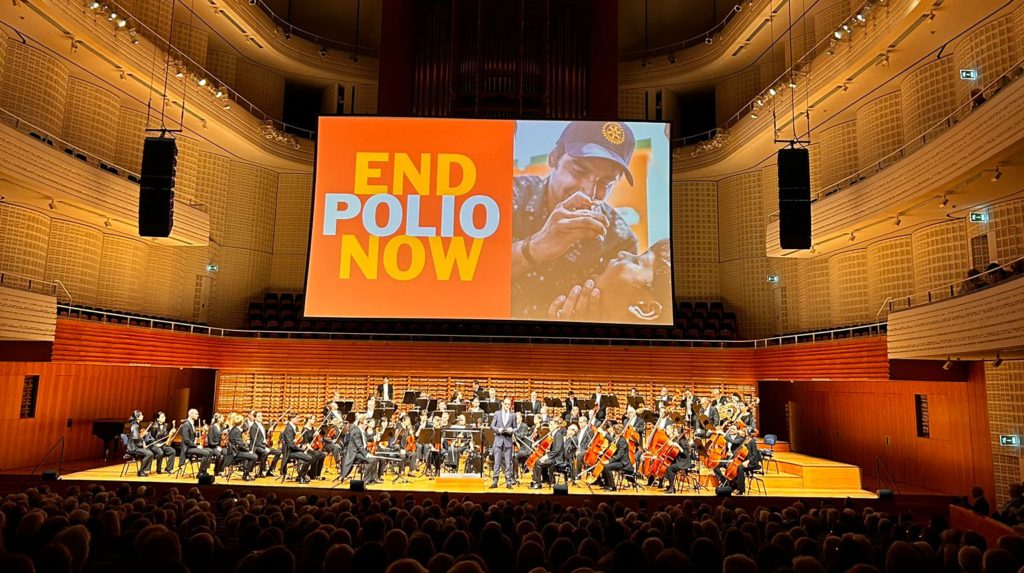Rotary Concert in Lucerne Raises Enough Funds to Save More than 100,000 from Lifelong Polio Paralysis – Global Polio Eradication

Report on the World Polio Day Benefit Concert and its Contribution to Sustainable Development Goals
1. Executive Summary
On 27 October 2025, Rotary International hosted a benefit concert in Lucerne, Switzerland, to support global polio eradication efforts. The event successfully raised CHF 48,000, sufficient to vaccinate over 100,000 children. This initiative directly supports the achievement of the United Nations Sustainable Development Goals (SDGs), primarily SDG 3 (Good Health and Well-being) and SDG 17 (Partnerships for the Goals), by mobilizing resources and strengthening global health partnerships to eliminate a preventable disease.
2. Event Details and Fundraising Outcome
- Event: World Polio Day Benefit Concert
- Organizer: Rotary International
- Location: Culture and Congress Centre (KKL), Lucerne, Switzerland
- Date: 27 October 2025
- Performance: The Stuttgarter Philharmoniker, conducted by Chloé Dufresne, with pianist Tsotne Zedginidze.
The concert concluded with the presentation of a cheque for CHF 48,000 to support the Global Polio Eradication Initiative (GPEI). This funding is a direct contribution to achieving key targets under SDG 3, specifically those related to ending epidemics of communicable diseases and ensuring universal access to essential vaccines.
Alignment with Sustainable Development Goals (SDGs)
3. Primary Contribution to SDG 3: Good Health and Well-being
The core objective of the event—the eradication of poliomyelitis—is a landmark public health goal aligned with SDG 3. The progress and continued efforts of the PolioPlus program, launched in 1985, demonstrate a significant impact on global health indicators.
- Disease Prevention: Funds raised will provide vaccinations for over 100,000 children, preventing lifelong paralysis and contributing to the goal of eradicating polio entirely.
- Reduction in Child Mortality and Morbidity: Since the program’s inception, polio cases have been reduced by over 99%, and an estimated 22 million people have been protected from paralysis. This represents a substantial contribution to ensuring healthy lives for all.
- Strengthening Health Systems: The infrastructure built for polio eradication often supports broader public health initiatives, reinforcing health systems in vulnerable regions.
As noted by Mike McGovern, Chair of Rotary’s International PolioPlus Committee, vigilance is required as “Polio can return anywhere until it is eradicated everywhere,” underscoring the importance of sustained action to secure the gains made towards SDG 3.
4. Exemplifying SDG 17: Partnerships for the Goals
The event and the broader polio eradication effort serve as a model for the multi-stakeholder partnerships required by SDG 17. The GPEI is a collaborative initiative built on global cooperation.
- Core Partners: The initiative is led by a partnership including Rotary International, the World Health Organization (WHO), UNICEF, the U.S. Centers for Disease Control and Prevention (CDC), the Bill & Melinda Gates Foundation, and Gavi, the Vaccine Alliance.
- Stakeholder Engagement: The concert itself brought together Rotarians, artists, and the public, demonstrating how civil society can mobilize resources and raise awareness for global goals.
- Global Solidarity: Dr. Jamal Ahmed, WHO Director for Polio Eradication, highlighted this partnership, stating, “Rotary’s unwavering leadership continues to inspire the entire global health community.” This reflects the spirit of global solidarity central to SDG 17.
5. Broader Impact on Other SDGs
The successful eradication of polio also contributes to other interconnected SDGs:
- SDG 1 (No Poverty) and SDG 10 (Reduced Inequalities): By preventing a disease that can cause permanent disability, the initiative helps break the cycle of poverty and reduces health inequalities, as polio disproportionately affects children in marginalized communities.
6. Conclusion and Forward Outlook
The World Polio Day concert in Lucerne was a successful fundraising and advocacy event that reinforced the global commitment to eradicating polio. Its outcomes directly advance the 2030 Agenda for Sustainable Development, particularly SDG 3 and SDG 17. The continued designation of polio as a Public Health Emergency of International Concern highlights the need for renewed determination from all partners. The event concluded with a clear message: collaborative action, driven by compassion and unity, is essential to turn the vision of a polio-free world into a lasting reality for all future generations.
Which SDGs are addressed or connected to the issues highlighted in the article?
SDG 3: Good Health and Well-being
- The article’s central theme is the global effort to eradicate polio, a debilitating communicable disease. This directly aligns with SDG 3’s mission to “ensure healthy lives and promote well-being for all at all ages.” The fundraising concert aims to finance vaccinations for children, a critical public health intervention to prevent disease and paralysis. The text explicitly mentions the goal of achieving a “world free of polio” and saving children from “lifelong polio paralysis.”
SDG 17: Partnerships for the Goals
- The article highlights the collaborative nature of the polio eradication effort, which is a core principle of SDG 17. It describes a multi-stakeholder partnership involving Rotary International (a civil society organization), the Global Polio Eradication Initiative (GPEI), and partners like the World Health Organization (WHO), UNICEF, CDC, the Gates Foundation, and Gavi. The article quotes Dr. Jamal Ahmed, who says, “Rotary’s unwavering leadership continues to inspire the entire global health community,” underscoring the importance of this partnership.
What specific targets under those SDGs can be identified based on the article’s content?
SDG 3 Targets
- Target 3.3: By 2030, end the epidemics of AIDS, tuberculosis, malaria and neglected tropical diseases and combat hepatitis, water-borne diseases and other communicable diseases.
- The article is entirely focused on the eradication of polio, which is a communicable disease. The stated goal to “finish the job” and create a “polio-free world” directly contributes to ending the epidemic of this specific disease.
- Target 3.b: Support the research and development of vaccines and medicines for the communicable and non-communicable diseases that primarily affect developing countries, provide access to affordable essential medicines and vaccines…
- The funds raised from the concert (CHF48,000) are explicitly for providing polio vaccines to “more than 100,000 children.” This action directly supports providing access to essential vaccines, particularly in the remaining affected regions of Pakistan and Afghanistan mentioned in the article.
SDG 17 Targets
- Target 17.16: Enhance the global partnership for sustainable development, complemented by multi-stakeholder partnerships that mobilize and share knowledge, expertise, technology and financial resources…
- The article is a clear example of this target in action. It describes the GPEI as a core partnership involving Rotary, WHO, UNICEF, CDC, the Gates Foundation, and Gavi. This collaboration mobilizes financial resources (the concert funds) and expertise to achieve the shared goal of polio eradication.
- Target 17.17: Encourage and promote effective public, public-private and civil society partnerships, building on the experience and resourcing strategies of partnerships.
- The partnership detailed in the article involves Rotary International (civil society), WHO (public), and the Gates Foundation (private), perfectly illustrating the type of cross-sector collaboration this target aims to promote. The article emphasizes that this partnership is “vital to finishing polio once and for all.”
Are there any indicators mentioned or implied in the article that can be used to measure progress towards the identified targets?
- Reduction in disease incidence: The article provides a clear metric for progress by stating that “the number of children paralysed by polio has dropped by over 99%, from nearly half a million cases every year to just a handful of districts in Pakistan and Afghanistan.” This directly measures progress against ending the polio epidemic (Target 3.3).
- Vaccination coverage: The funds raised are quantified in terms of impact: “enough funds to vaccinate more than 100,000 children.” The number of children vaccinated is a key indicator for measuring access to essential vaccines (Target 3.b).
- Financial resources mobilized: The article mentions the specific amount of “CHF48,000” raised. This figure serves as an indicator of financial resources mobilized through partnerships to support sustainable development goals (Target 17.16).
- Impact on human well-being: A powerful indicator of long-term success is mentioned: “Over 22 million people are walking today who would otherwise have been paralysed for life.” This measures the profound human impact of the health initiative, contributing to the overall goal of ensuring healthy lives (SDG 3).
SDGs, Targets, and Indicators Analysis
| SDGs | Targets | Indicators |
|---|---|---|
| SDG 3: Good Health and Well-being | 3.3: End the epidemics of… communicable diseases. |
|
| 3.b: Provide access to affordable essential medicines and vaccines. |
|
|
| SDG 17: Partnerships for the Goals | 17.16: Enhance the global partnership for sustainable development… that mobilize… financial resources. |
|
| 17.17: Encourage and promote effective public, public-private and civil society partnerships. |
|
Source: polioeradication.org
What is Your Reaction?
 Like
0
Like
0
 Dislike
0
Dislike
0
 Love
0
Love
0
 Funny
0
Funny
0
 Angry
0
Angry
0
 Sad
0
Sad
0
 Wow
0
Wow
0














































































